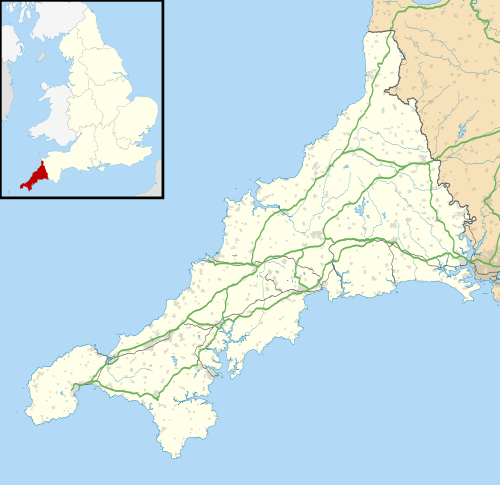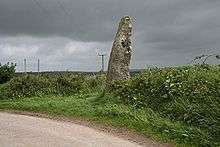Prospidnick
Prospidnick is a small village and hill in the parish of Sithney in Cornwall, United Kingdom.[1][2][3] It lies 0.6 miles east of Crowntown and 2.6 miles west of Wendron by road. It is divided into Lower Prospidnick and Higher Prospidnick.[4]
| Prospidnick | |
|---|---|
 | |
 Prospidnick Location within Cornwall | |
| Civil parish |
|
| Unitary authority | |
| Ceremonial county | |
| Region | |
| Country | England |
| Sovereign state | United Kingdom |
| Police | Devon and Cornwall |
| Fire | Cornwall |
| Ambulance | South Western |
History
Various spelling have been documented including Prospynneck, 1577; Prospynnecke, 1606; Prispynneck, Pryspinneck, c.1625; Prespynick, 1636; Prispidnick, 1665; Prospinnick, 1841, 1842; Prospidneck, 1884; and Prospidnick since 1996.[5] Historically, it was known for its granite hills; and the Propidnick Wheal Mine and quarry operated in the area.[6][7] In 1916, the Prospidnick Mining Company was reportedly interested in mining in Nancegollan.[8]
Geography

Along with Prospidnick, there are several other villages in Sithney parish; these include Guavas, Mellangoose, Higher and Lower Prospidnick, Tregoose, Trevarnoe, and Truthal.[9][10] The region is characterized by rock, granite,[11] wolfram and tinstone.[12] The easternmost of the two great granitic tracts in West Cornwall extends from Prospidnick and Nancegollan in the west to Ponsanooth and Budock to the east, and from near Polwheveral in the south to Wheal Butter to the north.[13]
Much of Longstone Downs was turned into tillable ground in the early 1880s by Mr R G Rowe who had a 99-year lease on the higher portion of Prospidnick Hill. Some of the surrounding area was not suitable for crops, Mr Bickford-Smith planted several acres of shrubs ″ ... which, it is hoped, will in a few years tend to relieve the monotony of the present appearance of the long stretch of the Prospidnick Hills.″[14]
Notable landmarks
Prospidnick Manor once belonged to the Arundells, then Christopher Wallis and in 1872 was reported to be in the property of his representative C W Popham.[15] The Prospidnick Long Stone is a 3 metres (9.8 ft) high standing stone, a large granite menhir, on Longstone Down, 660 metres (2,170 ft) northeast of Prospidnick Hill.[16] There is also logan stone (the Men Amber) and an overgrown cromlech.[17] The Cornish Heart Unit Fund has a building in the village. To the southwest there is a church called Chynhale Methodist Chapel. Some of the buildings in Prospidnick are cottages dated to the 18th century with thatched roofs.
Another landmark in Prospidnick is the Prospidnick Arch, a railway bridge that is part of the local Helston Railway. It is reported to be 40 feet (12 m) high and cost £1,000 in the early 1880s.[18]
References
- Treloar, Orson Lee (1962). Treloar genealogy: tree of Treloar. Paragon Press. Retrieved 17 January 2012.
- Lysons, Samuel (1814). Magna Britannia: being a concise topographical account of the several counties of Great Britain. Containing Cornwall. Cadell. p. 284. Retrieved 17 January 2012.
- Ordnance Survey: Landranger map sheet 203 Land's End & Isles of Scilly (St Ives & Lizard Point) (Map). Ordnance Survey. 2009. ISBN 978-0-319-23289-7.
- Great Britain. Ordnance Survey (1878). Book of reference to the plan of the parish of ... Printed by Eyre and Spottiswoode, for Her Majesty's Stationery Office. Retrieved 17 January 2012.
- "Prospidnick". Cornish Place Names. Retrieved 17 January 2012.
- Royal Cornwall (1868). Polytechnic Society. p. 19. Retrieved 17 January 2012.
- Walford, Edward; Cox, John Charles; Apperson, George Latimer (1886). Antiquary: a magazine devoted to the study of the past. E. Stock. p. 83. Retrieved 17 January 2012.
- Mining journal. Fisher, Knight & co., ltd. January 1916. p. 124. Retrieved 17 January 2012.
- "Magic Map Application". Defra. Retrieved 18 February 2016.
- Hitchins, Fortescue; Drew, Samuel (1824). The history of Cornwall: from the earliest records and traditions, to the present time (Public domain ed.). W. Penaluna. pp. 601–. Retrieved 17 January 2012.
- Spargo, Thomas (1865). The mines of Cornwall and Devon; statistics and observations (Public domain ed.). Emily Faithfull. pp. 53–. Retrieved 17 January 2012.
- Reid, Clement; Flett, Sir John Smith; Wilkinson, B. S. N.; Ernest Edward Leslie Dixon; William Pollard; Donald Alexander MacAlister (1907). The geology of the Land's End district (Public domain ed.). Printed for H.M. Stationery Off., by Wyman & Sons. pp. 115–. Retrieved 17 January 2012.
- Henwood, William Jory (1873). Observations on the detrital tin-ore of Cornwall. Netherton. p. 11. Retrieved 17 January 2012.
- "Improving Longstone Downs". The Cornishman (203 (193)). 1 June 1882. p. 4.
- Polsue, Joseph (1872). A complete parochial history of the county of Cornwall: compiled from the best authorities & corrected and improved from actual survey ; illustrated. W. Lake. p. 154. Retrieved 17 January 2012.
- "Prospidnick Menhir". Megalithic.co.uk. Retrieved 19 January 2012.
- Wade, Joseph Henry (1928). Rambles in Cornwall. Methuen & Co., ltd. p. 99. Retrieved 17 January 2012.
- "Inspection Of The Helston Railway Works". The Cornishman. 11 January 1883.